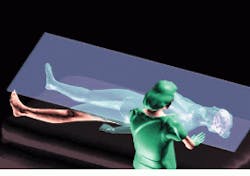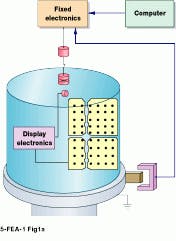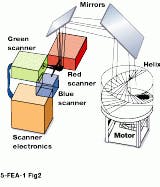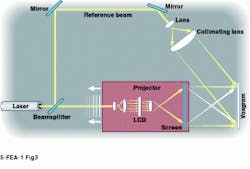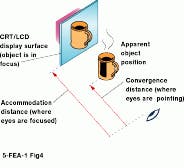New technologies vie with holographic techniques for 3-D displays
New technologies vie with holographic techniques for 3-D displays
By Andrew Wilson, Editor at Large
Today, the most common types of three-dimensional (3-D) visualization systems are stereoscopic or autostereoscopic. In both types, slightly different views of a scene are produced that correspond to the different views seen by each eye. Stereoscopic systems require the user to wear polarized glasses or liquid-crystal-display (LCD) shuttered glasses to separate these images. Unlike stereoscopic systems, autostereoscopic systems use lenticular lenses, prisms, light-blocking barriers, and other devices to place the optical element on the display screen without requiring the user to wear glasses.
Although lenticular systems suffer from narrow viewing zones in which the user can see the image, autostereoscopic and holographic-based 3-D systems have an advantage over stereoscopic systems because multiple views of objects can be visualized. By viewing the object at different points, the observer can move through multiple viewing zones to see the scene from different angles. While transitions from different zones can be abrupt, the observer can look around foreground objects to see objects in the background.
Such volumetric 3-D displays present an image so that observers can view it at any angle; both psychological and physiological depth cues are given. Several methods currently exist to produce 3-D images including rotational moving screen and varifocal imaging devices. Such display devices are now finding their way into commercial applications.
Rotating displays
An early 3-D display was developed by a student at the Massachusetts Institute of Technology (MIT; Cambridge, MA) in the late 1970s; Edwin Berlin developed a 3-D display based on a rotating matrix of light emitters. In 1990, this technology was licensed to Volumetric Imaging, which developed a low-cost system that displayed 1 million voxels simultaneously. After acquiring the rights to the technology, Holoverse (Cambridge, MA) developed the Model 200, 18-in.-diameter, 36-in.-high matrix imager system (see Fig. 1).
Like Holoverse, RGB Technology (Reston, VA) has also produced a display based on rotating components. In the company`s laser-projected 3-D volumetric display, a rotating helical-curved surface acts as a moving projection screen that sweeps out an image volume twice each revolution (see Fig. 2). Consisting of two equal halves, each full rotation of the helix at 600 rpm produces a 20-Hz image refresh rate.
In operation, a 3-D volumetric image is created on the helix using a laser scanner to provide x-y horizontal positioning. Vertical-positioning information is provided by modulating the laser beam in conjunction with the rotation-angle information from the helix shaft sensors. By projecting a short-duration laser on the diffuse helical screen, a visible spot (or voxel) is created. As the voxels are created in real space, normal parallax information is present and allows different perspectives of an image to be viewed by moving around the display.
Holographic displays
Conventional holograms are built by splitting a laser beam in two and illuminating holographic film with both the reference beam and the beam that is reflected from an object. The interference wavefront captured on the holographic film contains intensity, distance, and directional information.
However, reflecting light from an object is not usable when the object has been imaged using computed-tomography (CT) or magnetic-resonance-imaging (MRI) scans.
Because of this, Voxel (Laguna Hills, CA) has developed a novel method for producing 3-D images using such scans. The system consists of a Voxcam holographic camera, a Voxbox lightbox, and Voxfilm media. As a laser-driven optical instrument, the Voxcam receives images from CT or MRI scanners, projects them using an LCD, and records them on film. In this method, a hologram of the first slice is made. Then the screen is moved back a distance corresponding to the gap between the slices. Next, a second slice is projected, and a second hologram is superimposed on the first (see Fig. 3). More slices are encoded by repeating this procedure with appropriately greater distances used between the screen and the film.
This technique is similar to multiple-exposure photography, in which several exposures are made on a single segment of film. However, the holograms encode the location and the intensity of each exposure. When reconstructed, each holographic exposure appears at a different distance from the film; the slices are suspended in space with the correct separation between them.
After the film has been processed, it is displayed on the Voxbox. Similar in appearance to the lightboxes currently used in medicine for viewing conventional two-dimensional (2-D) film, the Voxbox uses ordinary white light to reconstruct the hologram rather than a laser. By rotating or tilting the Voxbox, the user can view a Voxgram from a variety of different perspectives.
Relieving eye strain
For stereoscopic and autostereoscopic systems, convergence and accommodation occur at different points in space, creating a source of eye strain. In these systems, the source of the image is a 2-D display, such as shown on a computer monitor. Although objects can appear to be either in front of or in back of the display, the images are generated and focused at only one distance. However, because objects can appear to be either in front of or in back of the display surface, the eyes are focused to a point in space where the object is perceived to be. Thus, attempts to use accommodation and convergence to view these images send conflicting signals to the brain.
Says Eugene Dolgoff of Floating Images (Westbury, NY), "We want to focus at one distance but aim our eyes at a different distance. This is not the way we are used to seeing, and it can result in eyestrain, fatigue, and headaches. In fact, the further the object is from the display surface, the greater this conflict and the harder it is to see the 3-D image" (see Fig. 4).
For these reasons, Dolgoff`s company has developed a 3-D visualization concept that eliminates the focus shortcomings. "Floating Images real-depth imaging allows accommodation to coincide with convergence to produce 3-D images that more naturally duplicate the way humans see," says Dolgoff.
To produce depth disparity, a virtual image plane must be produced in a different location in space. This technique produces depth disparity and can incorporate binocular parallax (vertical and horizontal) and traditional 2-D depth cues. It results in images that appear to float in free space and can be seen without wearing special glasses (see Fig. 5).
To fabricate this design, Floating Images provides a device called a real-depth adapter. Consisting of a fully reflecting mirror and a partially reflecting mirror, it is fabricated with plastic optics and fits over a computer screen. To take advantage of real-depth 3-D imaging, image-format-modification software allows the separation of images into foreground, background, and 3-D volume components. Also under development are algorithms that will eventually allow real-time reformatting of standard broadcast video into real-depth format.
Moving to 3-D
Although implementing real-depth imaging with two levels is straightforward, for compelling and natural-looking 3-D viewing, objects and images must move within a 3-D space. To accomplish this, methods must be developed that determine which objects or features belong in the foreground which belong in the background. For computer-graphics images, this determination is easier to accomplish than for video or real images. On computer-graphics images, features can be tagged with location coordinates to designate foreground or background status.
For video, other methods, such as spatial-frequency filtering, must be used. Such spatial-frequency filters can evaluate the visual appearance of various areas of the image frame. While areas of high detail, such as edges, have high spatial frequency, areas of low detail, such as background sky, have low spatial frequencies. These areas can be identified using electronic filters and separated into individual buffers for display in the foreground and background fields.
"Another challenge is to find ways to fill the space between the foreground and background image planes with 3-D moveable objects and images," says Dolgoff. "While some objects, such as characters, must move within these planes, other features, such as walls, may need to span the space from foreground to background," he adds.
To accomplish this space filling, several methods are under development at Floating Images. For example, modification of the various 2-D cues can be used to produce 3-D visualization. In many ways, real-depth imaging is compatible with the methods used to construct computer graphics and virtual reality worlds because 3-D coordinates are assigned to the component elements of many objects and features within these applications.
Free-space imaging
While products such as the real-depth adapter add a third dimension to a direct-view display, the most compelling application of real-depth technology is with free-space imaging systems. In these imaging systems, the concepts of real-depth imaging remain the same, but changes must be made in the display-device configuration to view the free-space imaging of 3-D images (see Fig. 6).
Floating Images has developed several free-space imaging systems. In one demonstration, the system floats images of a bust of Beethoven, moving it back and forth and rotating it in free space. This demonstration is visible under standard lighting conditions so that the projected objects appear to float over real objects that are several feet in front of the free-space imager.
Artist`s rendering portrays a 3-D volumetric imaging system.
FIGURE 1. Developed in the late 1970s, the Holoverse Model 200, 18-in.-diameter, 36-in.-high matrix imager system uses a rotating dispay of light emitters for a 3-D image. The technology has found success as a research platform in academia and as a display system for general advertising.
FIGURE 2. In RGB Technology laser-projected 3-D volumetric display, a rotating helical-curved surface is used as a moving projection screen that sweeps out an image volume twice each revolution. Projecting a laser on the diffuse helical screen creates voxels in a 3-D space.
FIGURE 3. Receiving images from a computer tomography or magnetic resonance scanner, the Voxcam projects the images using a liquid-crystal display and records the images on film. Once a hologram of the first slice is made, the projector is moved back a distance corresponding to the gap between the slices. The next slice is projected, and a second hologram is superimposed on the first. More slices are encoded by repeating the procedure.
FIGURE 4. When viewing an apparent object, stereoscopic and autostereoscopic systems produce differences in accommodation and convergence distances, unfortunately leading to eye strain, headache, and fatigue.
FIGURE 5. With two levels of depth disparity, a foreground image (the coffee mug) is formed on a computer monitor. Between the observer and the foreground image is a partially silvered mirror that allows the foreground image to be seen by the viewer with slightly reduced intensity. This partial mirror also reflects the background image represented by the starburst. It is formed in the bottom half of the same display or on a second display. Viewers can not see this image directly since it is blocked by the reflecting mirror. What appears, however, is a virtual image of the background that appears to be in back of the foreground image.
FIGURE 6. In the optical layout for a free-space imager, the image source is generated from a standard cathode-ray tube. If one source is used, the foreground and background image fields are formatted to appear in the top and bottom halves of the display, respectively. The two images are then combined using a partially silvered mirror. Then, the combined images are passed through Fresnel lenses that focus the background and foreground images at specific planes in space at some distance from the free-space imager. The 3-D images appear to float within the volume.
Holographic displays use crystals and gases to produce 3-D images
Andrew Wilson
Until recently, holographic displays have been limited to the production of two-dimensional (2-D) holograms and limited field-of-view 3-D holograms. But in applications such as medical imaging, air-traffic control, and virtual-reality displays, objects are more naturally interpreted when shown as true 3-D objects.
To accomplish this, researchers are studying the use of novel 3-D display media such as photorefractive crystals and rare-earth gases in which to generate true 3-D images. At 3D Technology Laboratories (Mountain View, CA) and AstroTerra (San Diego, CA), researchers are busy developing such 3-D displays.
In the system developed by 3D Technology, two computer-controlled lasers trace 3-D images inside a cube of glass doped with rare-earth elements. The energy generated at the point where the laser beams intersect in the glass makes a single pixel glow in space.
"This allows a pixel to be addressed anywhere inside the 3-D volume," says Elizabeth Downing, president of 3D Technology. "Then, by scanning the volume rapidly, a 3-D image can be drawn," she adds. At present, the prototype display is approximately 1 in.3 in volume, and the pictures are, at present, simple three-color line drawings (see photo). Downing believes, however, that there is no obstacle to making the viewing system larger.
Like the 3D Technology display, the system developed by AstroTerra also uses intersecting laser beams to produce 3-D images. In the AstroTerra system, however, two 630- and 780-nm laser beams are intersected in rubidium vapor, a technique that results in a visible red fluorescent image at the intersection point. "By adding lasers of different wavelengths, it is also possible to create green and blue fluorescence patterns and eventually full-color displays," says Eric Korevaar, president of AstroTerra.
By using computer controlled infrared lasers scanned inside a volume of erbium-doped fluoride glass, images can be created within a three-dimensional volume.
